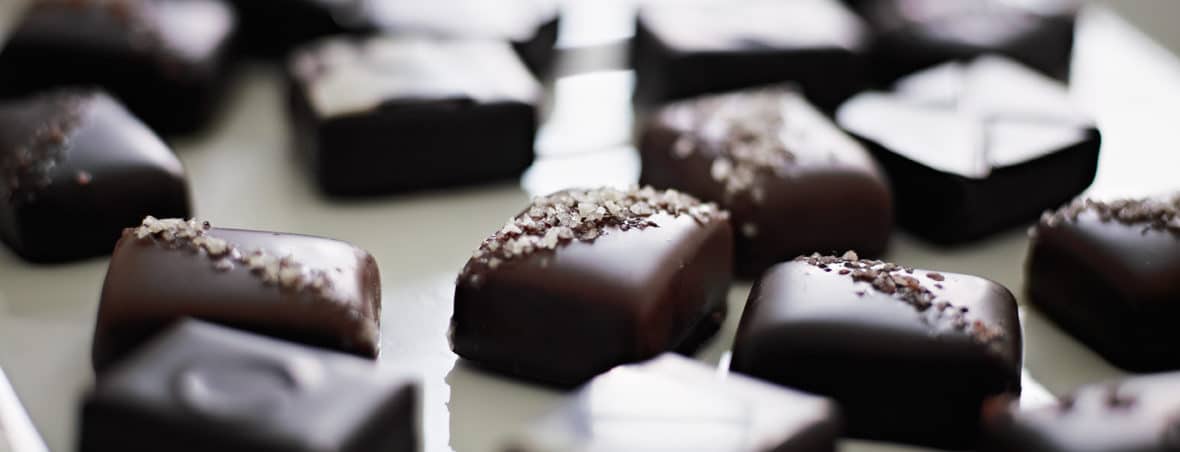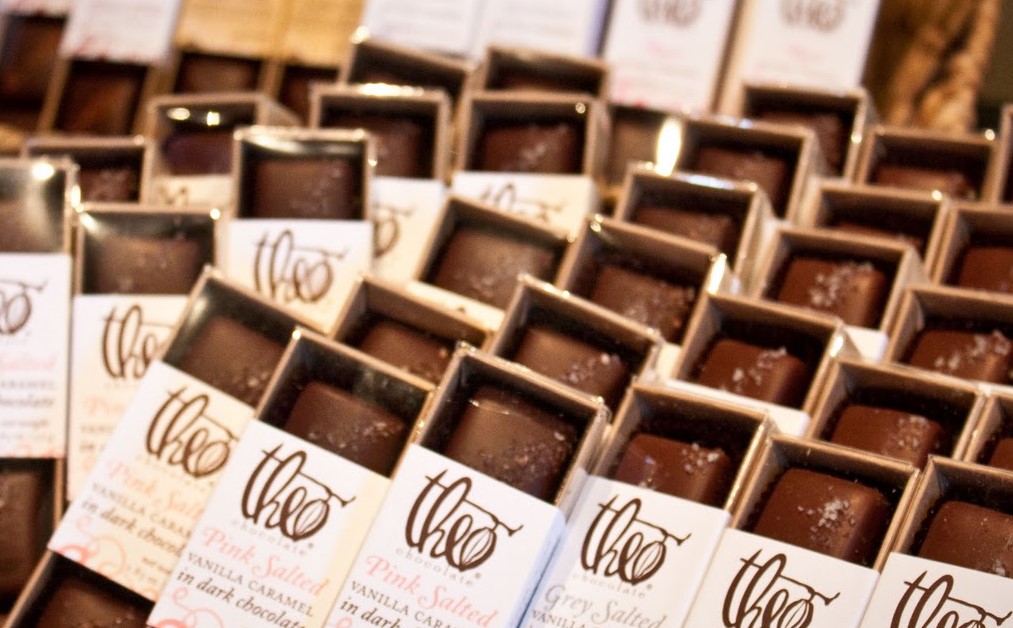
Nutritionist Pantry Food of the Gods
Nutritionist Pantry Food of the Gods
- posted on: February 22, 2016
- posted by: 21 Acres
"*" indicates required fields

As we’re nearing the end of February, we thought we’d point out that it is officially heart health month…yahoo! Actually, unless you’re a registered dietitian nutritionist who specializes in cardiovascular health (aka heart health), that celebration is probably not bolded on your calendar for this month. But what if I told you that with the celebration comes a free pass to indulge in as much chocolate as you like, with only a few minor stipulations? Yes, where is my party hat! Right, let’s get this party started!

Theobroma Cacao, or “food of the gods,” is the Latin name of the humble, yet delicious, plant that bears the fruit we have eventually come to love as chocolate. Archaeologists have seen references to the consumption of cocoa dating back at least 5,000 years in the area of Brazil and the Amazon.
Mayan stone temples display carvings of cocoa pods from 300 C.E. To the Mayans cocoa was a symbol of fertility, vitality, and life — who wouldn’t want a hefty daily dose! As the Mayan empire expanded, cultivating cocoa crops became a significant part of their culture. Cocoa, however, was not used as the sweet concoction we’re familiar with today. It was often used in religious ceremonies as a drink mixed with spicy peppers, cornmeal, and other foods (think molé sauce). Cocoa was known more for its bitter quality or “xocoatl-“ which is where we derive the word chocolate from. The Mayans brewed xocoatl to treat everything from an upset stomach, low energy and libido, to lowering fevers, drying internal phlegm, regulating sleep, anemia, and female infertility. Like many ancient cultures the Mayans met their cultural demise at the hands of invaders, the Aztecs. But the story of cocoa continues.
In 1200 C.E. the Aztecs conquered Mayan lands, yet continued their love of cocoa. Aside from using it as a powerful aphrodisiac and enlightening drink, the Aztecs also started to use cocoa beans as a form of currency and foundation for their culture; until the Europeans arrived…
“In fourteen hundred ninety-two, Columbus sailed the ocean blue,” Fast forward not quite 50 years later and Cortez also pays a visit to South America. While Columbus is initially credited with bring cocoa back to Spain, the monarchs at the time were more interested in the gold he pilfered than the bitter beans. Cortez’s shipment of cocoa, however, received a much better reception. So much so that Cortez was granted financial support to start cocoa plantations throughout South America. Since Cortez himself wasn’t fond of the bitter drink preferred by the natives, he began to experiment with adding sugar, spices, and vanilla – voila, the sweet decadence was born!
Nutritionally speaking, the darker the better. A higher percentage of cocoa compared to the amount of sugar or milk fat, the greater nutritional benefit. For example, 3 1/2 oz of unsweetened or barely sweetened (95% cocoa) yields 500 calories, 12.5 grams of protein, 52 grams of heart healthy fat, and 29 grams of carbohydrate . Not bad for a complete meal in a small plant-based package – it is a bean after all! The real heart protective properties come from the fabulous flavonoids (aka antioxidants or free radical fighting power). The same 3 1/2 oz of dark chocolate mentioned above boasts 170 milligrams of flavonoids. For comparison, a medium apple has about 106 milligrams. Dark chocolate also contains nearly 4 times the amount of antioxidants as black tea, and soars above red wine according to recent studies.
To get the smooth, rich mouth feel from a pure chocolate bar, cocoa butter is often added to the unsweetened cocoa powder. This deliciously satisfying plant-based saturated fat has been shown to not raise blood cholesterol. The high content of flavonoids may play a part in this function. They have also been shown to protect against cholesterol building up in the arteries and to keep blood from clotting – similar to the effects of baby aspirin. Both of these traits can be beneficial in reducing the risk of stroke and heart attack.
See why you earn a free pass to celebrate heart health month by eating as much chocolate as you like? But keep in mind, many of the these study findings were achieved using unsweetened cocoa powder or small amounts of a very dark chocolate bar. I typically steer clients toward at least 70%, but more strongly encourage 85-95% cocoa content in their chocolate treats. I also advocate that my clients choose their chocolate brands wisely from companies with a conscious mind for environmental, social, and economic sustainablity in the countries and regions where the cocoa is sourced.
My personal favorite is our hometown hero, Theo Chocolates. Theo was perhaps the first bean-to-bar chocolate producer in the US. They buy the cocoa directly from farmers and grower cooperatives, building long term partnerships. Theo supports Fair Trade by empowering farmers to take their livelihoods to the next level while participating in greater social change. Through education and community involvement, Theo supports organic growing practices, which encourage biodiversity and reforestation in order to benefit the fragile ecosystems where cocoa is commonly found.
In the 21 Acres kitchen, we aim to source as many of our ingredients within our state borders as possible. When we do need that particular chocolate flavor, however, we turn to Theo Chocolate for our ingredient needs as chocolate just can’t be produced in our cool climate. Just recently we hosted a chocolate themed heart health class. Theo’s was kind enough to donate all our chocolate ingredient needs. We look forward to continuing our partnership with this delicious and like-mind local company.
If you’re feeling the need for some chocolate goodness after reading about all its benefits, here are a couple of scrumptious recipes to delight your taste buds and give your heart some love.
— Amanda Bullat, M.S., R.D.N., C.D., Sustainable Food and Nutrition Education Coordinator
RECIPES:
Black Bean Enchiladas — adapted from Megan Ellison, RDN
1 cup chopped onion
1 T oil
3 garlic cloves, minced
1 tsp dried oregano
2 cans (15oz) no salt added black beans, drained and rinsed
1 T dried chipotle chili powder
¼ cup chicken broth, reduced sodium
½ cup asadero or Monterery Jack cheese, shredded
8 6” tortillas corn or whole grain
2 T + 2 cups preferred sauce – highly recommend the molé sauce from Bacelona Sauces out of Bend, OR
*can be found at most Whole Food Markets or Natural Grocers
1/2 cup feta cheese crumbles (optional)
——-
Preheat oven to 400 F.
Sauté onion in 1 T oil in large skillet over medium-high heat for 3 minutes. Add garlic and oregano and sauté for 1 more minute.
Puree half the beans, the chipotle, and 2 T of molé Barcelona Sauce in a food processor.
Combine the onion mixture, remaining whole beans, broth, bean puree and shredded cheese.
Warm tortillas in a clean cloth on top of the stove as the oven is preheating or use the microwave for 30 seconds. This helps to make the tortillas more pliable.
Assemble enchiladas with 1/3 cup black bean filling, rolling up, and topping with sauce and cheese crumbles.
Bake for 10 minutes.
Roasted Beet and Chocolate Salad Recipe — Megan Ellison, RDN
2 tbsp oil
1/4 tsp salt
1/4 tsp ground black pepper
6 small red beets
10-ounces lettuce mix
1/2 cup chopped walnuts
1/2 cup crumbled goat cheese
1/3 cup thinly sliced red onion or shallots
1/4 cup cocoa nibs
Cocoa Vinaigrette Ingredients
1/4 cup red wine vinegar
1/4 cup olive oil
1 tsp unsweetened cocoa powder
1 tsp honey
1/4 tsp salt
1/4 tsp fresh ground pepper
Peel the beets under running water to prevent staining. Pat dry with a paper towel and place on baking sheet.
Drizzle with olive oil and round to coat. Add pepper and salt. Bake for 45 minutes at 400 F. Let cool, then slice.
Whisk together ingredients for the vinaigrette in a bowl or place in a mason jar and shake to combine.
Prepare the salad and drizzle with dressing just before being served.
—
Amanda Bullat MS RDN CD is a registered dietitian nutritionist with master’s degree from Bastyr University and a background in natural and sustainable food systems. Amanda has taught classes for Whole Foods Market, Keene State College in New Hampshire, Seattle Mountaineers, and various other community organizations. When she is not teaching or coordinating our culinary education program, Amanda supports and inspires clients through her private nutritional counseling practice.











 back to blog overview
back to blog overview








